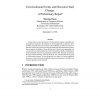Free Online Productivity Tools
i2Speak
i2Symbol
i2OCR
iTex2Img
iWeb2Print
iWeb2Shot
i2Type
iPdf2Split
iPdf2Merge
i2Bopomofo
i2Arabic
i2Style
i2Image
i2PDF
iLatex2Rtf
Sci2ools
KR
1992
Springer
1992
Springer
Conversational Events and Discourse State Change: A Preliminary Report
I argue that an action-based model of belief update is largely compatible with the proposals advanced in the literature on formal approaches to discourse interpretation, especially the recent work by Asher and Kamp, yet allows for a close integration between the processestracking the attentional state and performing intention recognition. In addition, I show that this kind of model, once augmented with a more expressive representation for events and situations, affords a formalization of phenomena like discourse segmentation and focus shift. The logic presented in the paper, besides allowing reasoning about the way conversational events group in conversational threads, is also appropriate as a target of a formal translation procedure, so that a discourse interpretation procedure alternative to the DRS construction algorithm can be specified.
Automated Reasoning | Discourse Interpretation | Discourse Interpretation Procedure | KR 1992 | Way Conversational Events |
| Added | 10 Aug 2010 |
| Updated | 10 Aug 2010 |
| Type | Conference |
| Year | 1992 |
| Where | KR |
| Authors | Massimo Poesio |
Comments (0)

